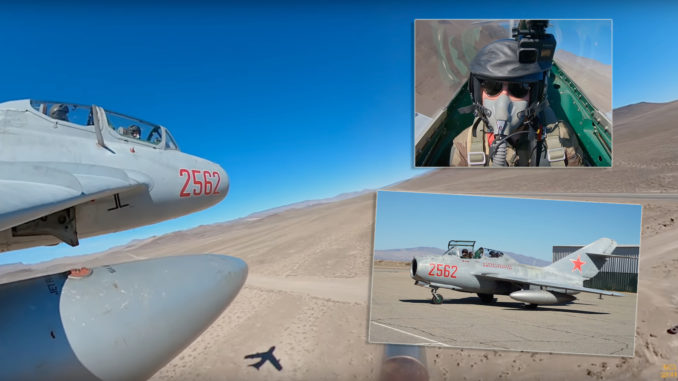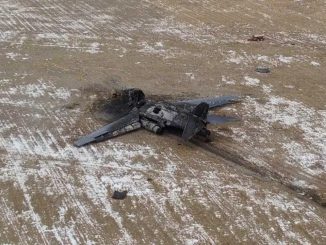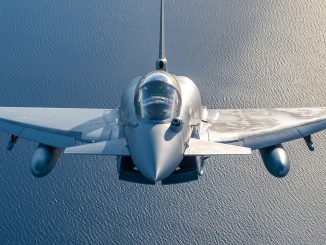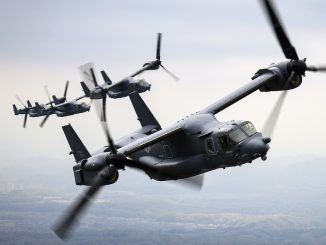
Amazing footage brings us back to the age of the “Red Eagles” of Project CONSTANT PEG.
Almost one year ago, we reported about a two-seat MiG-15UTI jet that was spotted in the Jedi Transition (the low level route aka the Star Wars Canyon) flying with an open Main Landing Gear door. This is what we wrote about that sighting: “A notable feature of Hernandez’s sightings and photos is that the right/starboard main landing gear door on the MiG-15UTI is open as it flew by. That may suggest a minor hydraulic problem on the old aircraft or an issue with the landing gear door linkage. On an older aircraft like the MIG-15, which first flew an amazing 72 years ago in 1947, it’s unlikely the pilot was even aware of the issue until after they landed. This relatively minor anomaly underscores the challenges of flying older, exotic, former Eastern Bloc aircraft in the adversary familiarization and flight test role.”
Interestingly, that was not the last time the very same aircraft, registration NX83GP “2562”, owned by private company Swift Air International, and often used for familiarization flights out of California City Airport, in the Mojave Desert, in California, flew the Sidewinder Low Level Route, once again with the right MLG door open!
On Feb. 1, 2020, 41-year old French private pilot Corentin Larose, was in the backseat of the MiG-15UTI “2562” piloted by Fred Bourdais, a French who works for Air France in LAX and lives in San Pedro for years. Corentin, who has a license for gliders, planes and helicopters and owns two helicopters, was shooting a video for his Youtube channel LOW FUEL – HELICOPTER LIFE, where he shares his passion for flying.
“For my 30th birthday, my wife offered me a flight on a Fouga Magister in California City (there is a sequence filmed in flight in the first episode of my channel); since then, I regularly came back to California City to fly Fougas. This year, I decided I would fly the MiG-15 and, on Feb. 1, we took off from California City Muni. Actually, Fred did the takeoff and landing, I did the rest of the flight,” Corentin explained in an email to The Aviationist.
Filmed with three GoPro 8 inside the cockpit and a GoPro Max on the wing (installed by means of an aluminium mount), you can follow Corentin’s flight in the MiG-15 over the western U.S..
Along with the scenery, the 16-min clip shows also another couple of interesting things. First of all, at the 02:44 mark you can see the MLG gear door opening. Exactly as happened in 2019, when we posted the photograph taken by Tyler Hernandez back then. But the minor gear door issue first spotted last year might have been just the beginning of major problem no one spotted until the 2020 flight and the severe failure the MiG-15 experience during Corentin’s flight. In fact, at the 11:30 mark, you can see the hydraulic emergency (caused by a leak, that was discovered after the successful landing) unfold: “I figured out we had a problem because I heard a cyclic noise going faster an faster, and felt it under my left foot. I recognised it probably was a “back and forth” hydraulic pump pumping in the void. At this moment, we were already headed to the airport because we were low in fuel. For a while, the landing gear didn’t want to lower, even when using the emergency procedure, then it eventually lowered”.
Emergency aside, the footage is simply stunning.
You can see the MiG-15 from every angle, including inside the small cockpit. The internal GoPro (and Corentin’s comments during the flight over the ICS) shows the scarce frontal visibility of the Soviet jet while the external one immediately brought to my mind the stories of the U.S. pilots flying the MiGs (-17 and -21) over the Nevada and California desert as part of the top secret CONSTANT PEG adversary simulation program described in detail by Col. Gaillard R. Peck Jr. in his “America’s Secret MiG Squadron” (one of the books that I’ve recently talked about with Tom Demerly in a Live Instagram Story).
The aircraft appears, as expected, pretty easy and fun to fly (consider that the U.S. pilots flying the MiG-17 – quite similar to the older MiG-15 – as part of the black CONSTANT PEG program did not have a two-seater for training ahead of their first flight in the Soviet jet) with an excellent horizontal turn performance: “it turns more like a Cessna than a fighter jet”, Col. Peck says in his book. It’s also maneuverable on the roll axis as well as fast a stable at low level (420 knots on the GPS). Overall, it was a tough adversary for U.S. straight-wing jets during air combat in the Korean War and for all the western fighters throughout the first part of the Cold War, and today remains a fascinating warbird.
The MiG-15 series of aircraft is one of the most produced jet fighter in history, with some sources suggesting over 13,000 were built for use not only by USSR but especially by former Soviet Bloc countries such as North Korea. The aircraft helped define the jet age of aerial combat in engagements over North Korea with the American F-86 Sabre. Famous Russian cosmonaut and first man in space, Yuri Gagarin, died in the crash of a MiG-15UTI in 1968. His crash was attributed to poor weather and a lack of accurate ground vectoring communication however, not any anomalies of the MiG-15UTI’s flight envelope.



